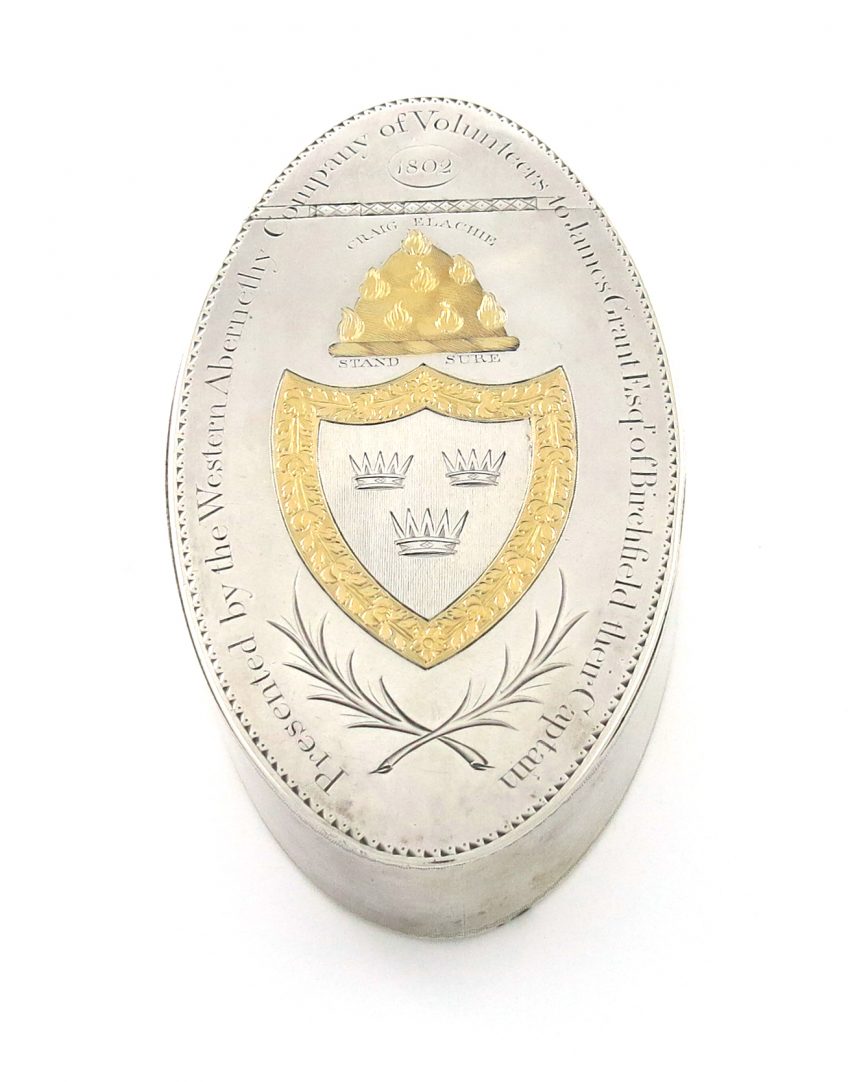A George III silver snuff box, presented to “the good Sir James”, who served as an MP for what was then Elginshire and later as MP for Banffshire, is one of the objects of particular interest at an auction being held at the prestigious Woolley & Wallis salerooms in Salisbury next week (Wednesday July 14).
The box, which bears the inscription “Presented by the Western Abernethy Company of Volunteers to James Grant of Birchfield their Captain”, was presented by the men to Sir James Grant, 8th Baronet of Colquhoun, who raised the Strathspey Battalion of Volunteers in 1798.
The battalion was part of a network of volunteer units raised across the country following the French Revolution when it seemed as though war between France and Great Britain was inevitable.
Sir James, who owned large estates in Strathspey, first raised a voluntary unit, the Grant Fencibles, almost entirely from his tenantry in 1793. Fencibles (from the word defensible), were raised during the late 18th and early 19th centuries, to defend against the threat of invasion during the Seven Years’ War, the American War of Independence, the Napoleonic Wars, and the War of 1812. Generally assigned local duties on patrol or in garrisons, their presence meant the regular army could turn their attention to more offensive operations.
The Grant Fencibles were disbanded six years later. Grant then raised the Strathspey Battalion of Volunteers which first met in Grantown-on- Spey in 1798. There were two companies, Eastern and Western Abernethy, and Grant became captain of the 80-strong Western Company.
Born in Moray, James Grant succeeded his father as MP for Elginshire in 1761, holding the seat until 1768. In 1783, he was one of the founders of the Royal Society of Edinburgh. He returned to politics in 1790, serving as MP for Banffshire until 1795, and as Lord Lieutenant of Inverness-shire. He died at the family seat at Castle Grant in 1811 aged 72.
The snuff box, made by Alexander Gardner and Co of Edinburgh in 1802, is valued at between £2,000-£3,000. It is one of 24 snuff boxes from the Lion Collection, a grouping which categorises some of the most interesting, rare, and varied examples of antique British silver boxes, which will go under the hammer at the two-day auction on July 13 and 14.
Another item from the Lion Collection, an 18th century Scottish provincial snuff mull, made by Robert Anderson of Inverness around 1760 and valued at £800-£1200 is also for sale.
The auction features several other notable Scottish lots, including a George III silver
soup tureen, valued at £3,000-£4,000, which bears the crest of St Clair, Earls of Rosslyn is also up for auction. The family owns Rosslyn Chapel, made famous in Dan Brown’s book The Da Vinci Code.
Curling fans might also be interested in a Scottish silver-mounted hardstone inkwell in the shape of a curling stone with a hinged handle which slides aside to show the well. The Victorian novelty item, bearing a crest attributed to Bendyshe, Cramer, Doran and more is inscribed “From G and F.C”. Measuring just 7.3cm (just under 3in) it goes on sale with a valuation of between £200-£300. For information on how to bid online or by telephone for the Silver & Objects of Vertu auction on July 13 & 14, visit www.woolleyandwallis.co.uk
